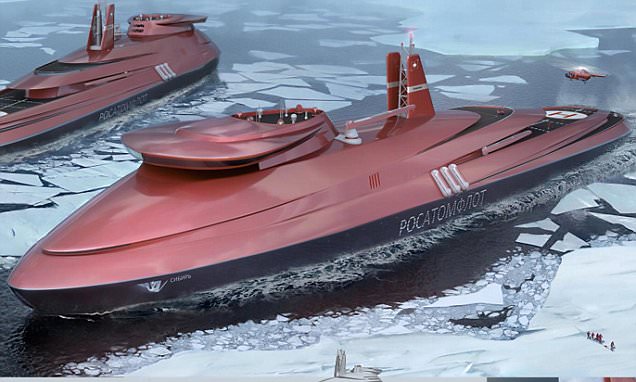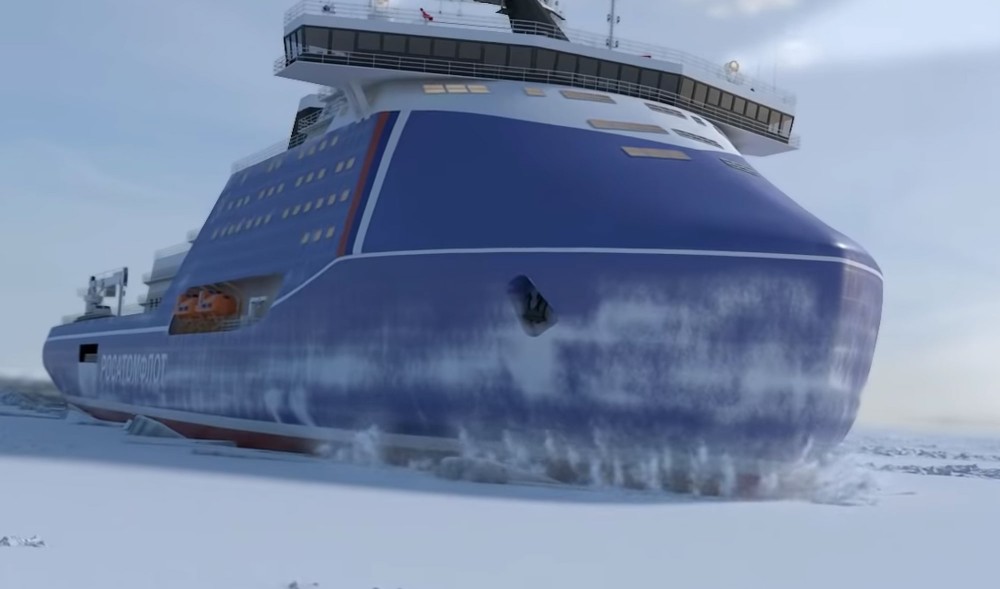
The system built to manage Russia’s nuclear legacy is crumbling, our new report shows
Our op-ed originally appeared in The Moscow Times. For more than three decades, Russia has been burdened with the remains of the Soviet ...
News

Publish date: October 31, 2018
News
The Leader, a Russian nuclear icebreaker that has existed in mythical blueprint since 2015, has become a political dispute as shipbuilders argue over where its science fiction proportions should be made a steel reality.
When the Leader – or Lider as it’s known in Russian – made its debut on the slick cover of the United Shipbuilding Corporation’s glossy trade magazine in December 2015, it appeared, at first glance, to be nothing more than an expensive fantasy –– a sort of pin-up fawned over by engineers who knew their chances of ever meeting it in real life were slim.
In the magazine, the sleek vessel was pictured from the point of view of helicopter poised to land on its deck as it steamed through puffy islands of ice. The airy vision seemed more similar to a prized yacht from the collection of a Kremlin-friendly oligarch than it did to any of Russia’s draught horses of Arctic icebreaking.
Its dimensions seemed likewise incredible. At 205 meters and 71,000 tons, it would weigh in at 50 meters longer and thousands of kilograms heavier than Russia’s three largest icebreakers, which are themselves still under construction. Its two experimental RITM 400 reactors would be capable of propelling it through the thickest ice the Arctic can dish out, while maintaining a hull shallow enough to make it useful in navigating the Arctic’s river tributaries.
Even its maintenance needs would be minimal. According to reports in Russia’s shipbuilding trade press, the Leader vessels would come equipped with materials capable of “self-diagnosing” metal corrosion, and would further be able to “self-heal” when damage is detected. And the superlatives didn’t end with that. Many in Russia’s official press have championed the Leader as nothing less than the engine of the country’s economic turnaround.
Impossible, said many.
But the idea caught on in official circles, and now, with Rosatom, Russia’s state nuclear corporation, slated to take control of infrastructure development along the Northern Sea Route, the fantasy icebreaker began to sprout political cheerleaders, a construction timetable, a $1.6 billion budget, and a group of shipbuilding contractors fighting over how to spend it.
 The Leader nuclear icebreaker as envisioned in a promotional video.
Credit: Rosatom
The Leader nuclear icebreaker as envisioned in a promotional video.
Credit: Rosatom
In September the Putin administration decided to shine its favor on the ailing Zvezda shipyard, located in far eastern Vladivostok –– far from the usual centers that have traditionally forged the backbone of the vaunted Soviet, now Russian, nuclear icebreaking fleet.
Now, however, the United Shipbuilding Corporation, whose trade magazine brought the Leader project its original glitter and fame, is feeling jilted, and crying foul that the Kremlin is tipping the scales against it.
Earlier this week, the corporation’s head, Alexei Rakhimov told the RBK Russian business newswire that the apparent decision to build the Leader at Zvezda politically motivated and made bad economic sense.
In point of fact, the failing shipyard has failed to produce much of anything but debt ever since the heyday of nuclear submarine decommissioning ended in the early 2000s – throughout which Zvezda was kept afloat by cash from American nuclear disarmament agreements.
Rakhimov told RBK that the Zvezda would be swamped by an order to produce the Leader. Its technicians, he said, have never built a nuclear icebreaker before, and Zvezda’s management would have to import abler minds from other shipyards that have, like the Baltic Shipyard in St Petersburg – which is where those other three new nuclear icebreakers are being built.
But its not so much what Rahkhimov said as what he didn’t have to say directly – and that’s that the Zvezda shipyard is not owned by the Unified Shipbuilding Corporation – as are the vast majority of Russia’s shipyards, including the Baltic Shipyard.
Instead, Zveda is owned, at least in part, by Rosneft, Russia’s giant state oil drilling firm, and Rosneft is in turn headed by Igor Sechin, widely regarded as one of Putin’s closest political allies.
Ever since 2013, Putin has backed Rosneft’s takeover of the Zvezda shipyard as part of a broader effort to pour cash into the far-flung Russian East – where political support for the president is patchy at best.
The region’s close proximity to China has long created headaches for the Kremlin, which has long struggled in a battle for influence from seven time zones away. More recently, Far Eastern politicians from Kremlin backed parties have been taking a drubbing at the polls.
All of this calls into question what the real point of the Leader really is. As Russia prepares to launch three more nuclear icebreakers over the next few years, on top of the five it still has in operation, it’s questionable whether it will need a new one any time soon – especially one more aptly suited movie fantasies.
Unless the point of the Leader has been merely political all along, in which case it hardly matters if it is ever built. It’s clearly served its purpose already.

Our op-ed originally appeared in The Moscow Times. For more than three decades, Russia has been burdened with the remains of the Soviet ...

The United Nation’s COP30 global climate negotiations in Belém, Brazil ended this weekend with a watered-down resolution that failed to halt deforest...

For more than a week now — beginning September 23 — the Zaporizhzhia Nuclear Power Plant (ZNPP) has remained disconnected from Ukraine’s national pow...

Bellona has taken part in preparing the The World Nuclear Industry Status Report 2025 and will participate in the report’s global launch in Rome on September 22nd.